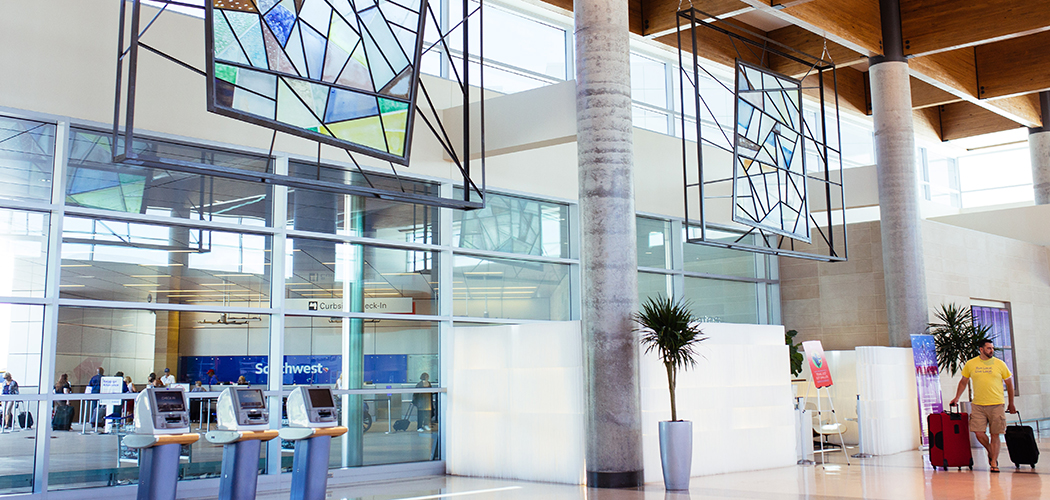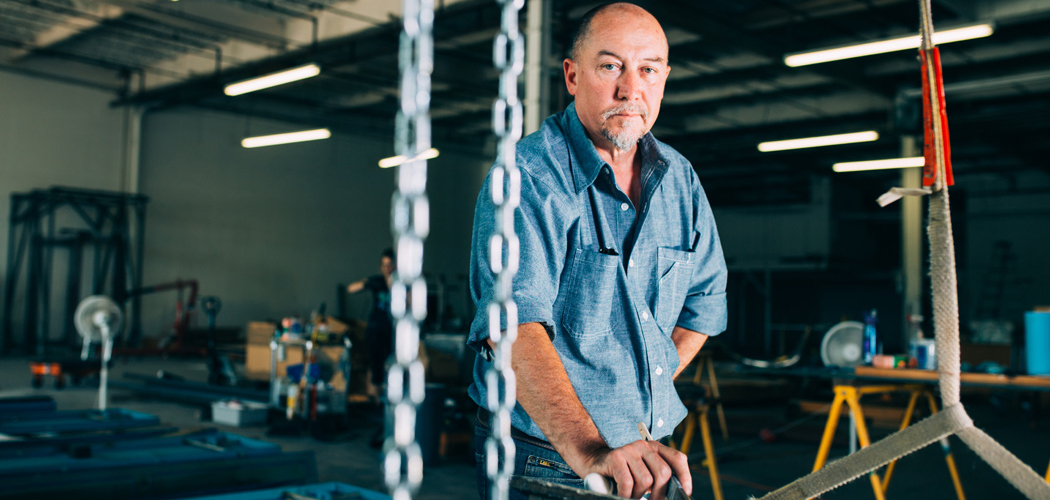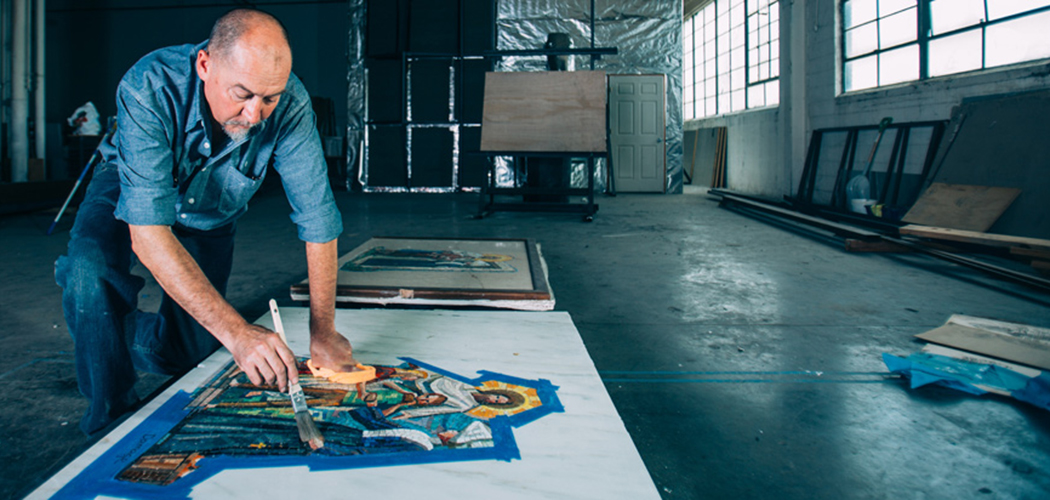Two women wearing t-shirts that read “Van Enter Studio” crouch on the floor at Dallas Love Field in front of a half-finished piece of glass artwork.
They work in tandem. After placing a slice of colorful glass into the large metal framework, one holds the glass in place as the other secures it with pins and glue. Then they wipe it clean and move onto the next piece, and one by one the web of crisscrossing metal fills with fused glass.
Just a few steps away, two similar pieces already hang from the ceiling in front of large windows. Light fills the artwork and illuminates the patterns made from bubbles, streaks and carefully arranged chunks of glass that were melted onto the surface.
Curious travelers on their way to and from the airport’s ticket counters pause to look at the eye-catching art. They learn this is the end of a long journey for the four elaborate pieces, which have passed through several East Dallas hands before landing here.
“It definitely catches people’s attention,” says Michael Van Enter, the neighborhood artist responsible for restoring the glass and displaying it at Love Field.
The fused glass is the work of artist Octavio Medellin who lived and worked in East Dallas for decades, although his influence reaches far beyond Dallas.
Medellin originally designed the glass to adorn Trinity Lutheran Church on Gaston, which was demolished in the fall of 2013 to make way for the new White Rock YMCA that opened this spring.
The name Octavio Medellin has been circulating through the local media, along with details about the glass, which the city called “historically significant.”
But who was Medellin, and why is his work so “significant”?
“Octavio was a really dynamic artist,” Van Enter explains. “He was seen on a national basis as a pioneer in his field. He didn’t just make junk. He made quality stuff, and he left a legacy.”
Medellin’s glass work is an important part of that legacy. Although the glass from Trinity Lutheran Church looks like stained glass to the untrained eye, it isn’t; it’s fused glass, born of an artistic technique Medellin created in the 1950s.
Medellin used glazes similar to those used in ceramics. He slathered glaze onto a slice of glass and then he fired the glass inside a kiln, allowing the glaze and the glass to “fuse” together. His mixture resulted in unpredictable blistered and crackled textures. Similar to working with pottery, more glaze means darker, richer colors and less glaze means lighter, faded colors — both of which can be seen in the glass pieces at Love Field.
Medellin experimented with the process extensively and took copious notes. Van Enter says some Dallas artists still use the fused glass technique as a direct result of Medellin’s teaching and influence. “It’s an art form that has still kind of stayed in Dallas,” Van Enter says.
As a child in 1920, Medellin moved to Texas with his family from San Luis Potosi, Mexico. He began studying art at the San Antonio Art Institute under the tutelage of the influential Spanish artists Jose Arpa and Xavier Gonzales.
Medellin later studied at the Chicago Art Institute before he returned to Mexico for a three-year study of the country’s art, customs and history, which had a major influence on his artistic style. Medellin eventually made his way to Dallas, where he made his home until 1999, when he died at age 92.
Medellin contributed to the Dallas art scene beautiful sculptures, paintings, murals and glass, which are featured at the Dallas Museum of Art, the Amon Carter Museum and the Museum of Modern Art in New York. He also taught at North Texas State Teachers College, Southern Methodist University and the Dallas Museum of Fine Arts School.
He founded the Octavio Medellin School of Sculpture, which later morphed into the Creative Arts Center (CAC) in East Dallas where many of Dallas’ most influential artists and art teachers studied his techniques.
East Dallas painter and sculptor Marty Ray took lessons from Medellin before moving on to SMU to earn her Master of Fine Arts. Medellin’s dedication to artistic integrity was infectious, Ray says. (Diana Pollak, the CAC’s executive director, says Medellin would roll over in his grave if he knew the students no longer make their own clay.)
Even non-artists took his classes — doctors, lawyers and regular folks who simply wanted to soak up some of his passion — and he worked hard to make art accessible to everyone.
“He was fun, he had passion for art, and he had a certain way of teaching,” Ray explains. “He was a natural artist with some training, although he didn’t have a formal degree. His students loved him, and he had many devout followers.”
In 1960 Medellin created the glass windows for Trinity Lutheran Church using his fused glass technique. The work was once one massive piece placed in the church’s bell tower – the outside wall on the front of the building. To restore for the Love Field display, Van Enter “tipped the piece over” on its side and broke it into four parts, which he set inside four custom-designed metal frames.
There were also several floor-to-ceiling pieces along the side of the church, which Van Enter is in the process of restoring. They will be installed at the Dallas City Performance Hall in July.
For some the fused glass is the only remainder of the church that once graced the top of the hill at Gaston and Loving.
“Throughout the years, whenever the sermons were boring, I loved the windows,” quips East Dallas neighbor Marilyn Hansen, whose father-in-law was the first president of the congregation.
But it’s the East Dallas artist community that seems to find the most significance in Medellin’s leftover glass work.
When the White Rock YMCA purchased Trinity Lutheran Church, it planned to demolish the church and simply destroy the fused glass along with it.
But sculptor David Hickman, who was a major player in the East Dallas arts community before he recently moved to Santa Fe, learned about the demolition and intervened just in time.
Hickman is a former student of Medellin, which gave him an appreciation for both the monetary value of the glass as well as the historical significance of the piece.
“I’d known about the glass for some time,” Hickman explains. “So I got really concerned when I learned the YMCA was buying the property and that they were probably going to raze the building and destroy the glass if someone didn’t tell them what they had.”
Hickman reached out to the White Rock YMCA’s architect Craig Reynolds and urged him to consider saving the glass. Together they visited the property while Hickman tried to decide if he was capable of removing and restoring it himself.
“I’m a one-man studio now, so I don’t have a big operation,” Hickman points out. “I finally realized that there was no way that I was going to be able to disassemble those windows safely.”
Instead he contacted Van Enter, another East Dallas artist, who has a team of five full-time staff members and two part-time technicians. But more importantly Van Enter specializes in fine art conservation and has experience working on similar projects.
“I thought this was the perfect project for him,” Hickman says.
From there everything happened quickly. The YMCA turned the glass over to the city’s public art program, and the Office of Cultural Affairs began scouring Dallas for possible donors. Once the city found someone to sponsor the project, Van Enter’s team spent several weeks removing the glass from the church.
For two years the glass sat in Van Enter’s workshop, which is housed in an old East Dallas factory built in the 1930s to produce Ford cars and then Mustang fighter planes during World War II.
Van Enter constructed an airtight room inside his workshop to keep dust away from the project while his team worked to restore any damaged pieces.
Hickman possessed several boxes of Medellin’s supplies and heavy-duty equipment for making fused glass, but when Hickman moved to Santa Fe he gave it to Van Enter for safekeeping and possible future use. However, Van Enter never used the supplies during the restoration process. Instead he opted for more modern repair methods.
“We didn’t re-melt pieces of glass,” he says. “We used high-tech resins and glues to put everything back together. There was a hole that we repaired. You can barely see it, but it’s there. We used acrylics to fill in the cracks and modern paint.”
I
n the end Van Enter lost money on the project, but he says he’d do it again because saving Medellin’s work is worth it. Plus, anytime Van Enter has a chance to restore old artwork — something he does often — he says it’s “very gratifying.”
“It’s nice to bring things back to their original,” he points out.
This isn’t the first time Van Enter and his team have recovered and restored Medellin’s artwork. Van Enter also saved several large murals from the Mercantile Bank before it was razed. They had three months to remove the murals, which are now in the Joule Hotel in downtown Dallas.
Van Enter never met Medellin, so his impression of him is based purely on the legacy Medellin left behind, but working so closely with Medellin’s artwork has given Van Enter a unique perspective.
“There is a signature I keep seeing in his work,” he says. “There’s a lot of light and line. That line becomes a characteristic in his work. And there’s a lot of brightness contrasted with earth colors. I think that comes from when he studied Mayan art. It’s so unique.”
Although Van Enter’s artistic style is very different from Medellin’s, their artistic processes are somewhat similar. Both artists work in abstract, but neither work at random.
“He was very scientific in his approach,” Van Enter says. Although today Van Enter is an artist with a bent toward abstract metal sculpting, his background is in engineering, which has made him a lover of all things planned and calculated.
“[Medellin] bridged the world between artisan and artist,” Van Enter explains.
By the ’60s, when America was caught up with abstract artists like Jackson Pollock and Helen Frankenthaler, who were busy creating a new Post World War II art intellectual movement, Medellin was working to fuse the old with the new.
“At the same time that the use of the craftsmanship drops off, Octavio brings the craftsmanship back and says, ‘You can be abstract but you have to be meticulous,’ ” Van Enter says.
“So when the rest of the world is rushing to do immediate art and universities were caught up in that, he brought this to Dallas.”
Van Enter also admires Medellin for working collaboratively with other artists at a time when creating art was often a selfish venture.
“In that era it was all about the artist. The artist was the hero, not the painting,” Van Enter says.
He is pleased to see Medellin’s work and influence once again being recognized in Dallas. Not only is his art receiving a new life at Dallas Love Field and the Dallas City Performance Hall, but in a way so is Medellin.
“It’s nice to see his name being brought back up,” Van Enter concludes.
Where is it?
See Medellin’s fused glasswork near the ticketing counters at Dallas Love Field. The other pieces will be installed at Dallas City Performance Hall this month.
You can also find several of Medellin’s murals in the Joule Hotel in downtown Dallas.
To learn more about Medellin, see a digital collection of his work at SMU’s Bywaters Special Collections at the Hamon Arts Library. Visit digitalcollections.smu.edu.








